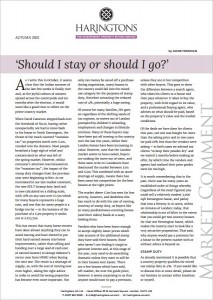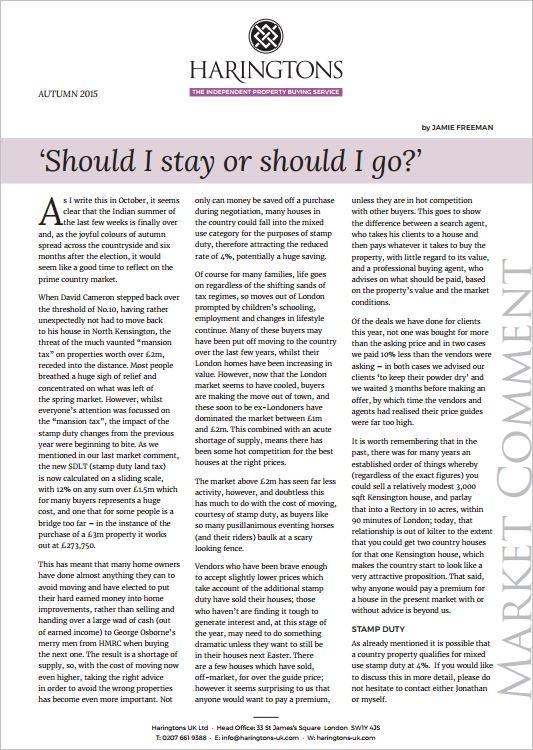
Market Comment, Autumn 2015
As I write this in October, it seems clear that the Indian summer of the last few weeks is finally over and, as the joyful colours of autumn spread across the countryside and six months after the election, it would seem like a good time to reflect on the prime country market.
When David Cameron stepped back over the threshold of No.10, having rather unexpectedly not had to move back to his house in North Kensington, the threat of the much vaunted “mansion tax” on properties worth over £2m, receded into the distance. Most people breathed a huge sigh of relief and concentrated on what was left of the spring market. However, whilst everyone’s attention was focussed on the “mansion tax”, the impact of the stamp duty changes from the previous year were beginning to bite. As we mentioned in our last market comment, the new SDLT (stamp duty land tax) is now calculated on a sliding scale, with 12% on any sum over £1.5m which for many buyers represents a huge cost, and one that for some people is a bridge too far – in the instance of the purchase of a £3m property it works out at £273,750.
This has meant that many home owners have done almost anything they can to avoid moving and have elected to put their hard earned money into home improvements, rather than selling and handing over a large wad of cash (out of earned income) to George Osborne’s merry men from HMRC when buying the next one. The result is a shortage of supply, so, with the cost of moving now even higher, taking the right advice in order to avoid the wrong properties has become even more important. Not only can money be saved off a purchase during negotiation, many houses in the country could fall into the mixed use category for the purposes of stamp duty, therefore attracting the reduced rate of 4%, potentially a huge saving.
Of course for many families, life goes on regardless of the shifting sands of tax regimes, so moves out of London prompted by children’s schooling, employment and changes in lifestyle continue. Many of these buyers may have been put off moving to the country over the last few years, whilst their London homes have been increasing in value. However, now that the London market seems to have cooled, buyers are making the move out of town, and these soon to be ex-Londoners have dominated the market between £1m and £2m. This combined with an acute shortage of supply, means there has been some hot competition for the best houses at the right prices.
The market above £2m has seen far less activity, however, and doubtless this has much to do with the cost of moving, courtesy of stamp duty, as buyers like so many pusillanimous eventing horses (and their riders) baulk at a scary looking fence.
Vendors who have been brave enough to accept slightly lower prices which take account of the additional stamp duty have sold their houses; those who haven’t are finding it tough to generate interest and, at this stage of the year, may need to do something dramatic unless they want to still be in their houses next Easter. There are a few houses which have sold, off-market, for over the guide price; however it seems surprising to us that anyone would want to pay a premium, unless they are in hot competition with other buyers. This goes to show the difference between a search agent, who takes his clients to a house and then pays whatever it takes to buy the property, with little regard to its value, and a professional buying agent, who advises on what should be paid, based on the property’s value and the market conditions.
Of the deals we have done for clients this year, not one was bought for more than the asking price and in two cases we paid 10% less than the vendors were asking – in both cases we advised our clients ‘to keep their powder dry’ and we waited 3 months before making an offer, by which time the vendors and agents had realised their price guides were far too high.
It is worth remembering that in the past, there was for many years an established order of things whereby (regardless of the exact figures) you could sell a relatively modest 3,000 sqft Kensington house, and parlay that into a Rectory in 10 acres, within 90 minutes of London; today, that relationship is out of kilter to the extent that you could get two country houses for that one Kensington house, which makes the country start to look like a very attractive proposition. That said, why anyone would pay a premium for a house in the present market with or without advice is beyond us.
Stamp Duty
As already mentioned it is possible that a country property qualifies for mixed use stamp duty at 4%. If you would like to discuss this in more detail, please do not hesitate to contact either Jonathan or myself.
